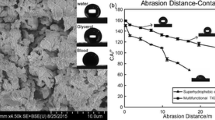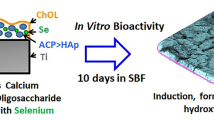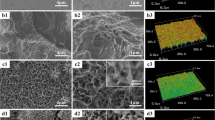Abstract
Microporous titanium carbide coating was successfully synthesized on medical grade titanium alloy by using sequential carburization. Changes in the surface morphology of titanium alloy occasioned by sequential carburization were characterized and the wettability characteristics were quantified. Furthermore, the dispersion forces were calculated and discussed. The results indicate that sequential carburization is an effective way to modify the wettability of titanium alloy. After the carburization the surface dispersion force of titanium alloy increased from 76.5 × 10−3 J·m−2 to 105.5 × 10−3 J·m−2, with an enhancement of 37.9 %. Meanwhile the contact angle of titanium alloy decreased from 83° to 71.5°, indicating a significant improvement of wettability, which is much closer to the optimal water contact angle for cell adhesion of 70°.
Similar content being viewed by others
References
Luo Y, Ge S. Load dependence of nanohardness in nitrogen ion implanted Ti6Al4V alloy and fractal characterization. Journal of China University of Mining and Technology, 2007, 17, 363–367.
Fini M, Nicoli Aldini N, Torricelli P, Giavaresi G, Borsari V, Lenger H, Bernauer J, Giardino R, Chiesa R, Cigada A. A new austenitic stainless steel with negligible nickel content: An in vitro and in vivo comparative investigation. Biomaterials, 2003, 24, 4929–4939.
Habibovic P, Li J P, van der Valk C M, Meijer G, Layrolle P, van Blitterswijk C A, de Groot K. Biological performance of uncoated and octacalcium phosphate-coated Ti6Al4V. Biomaterials, 2005, 26, 23–36.
Surowska B, Bieniaś J, Walczak M, Sangwal K, Stoch A. Microstructure and mechanical properties of ceramic coatings on Ti and Ti-based alloy. Applied Surface Science, 2004, 238, 288–294.
Hoseini M, Jedenmalm A, Boldizar A. Tribological investigation of coatings for artificial joints. Wear, 2008, 264, 958–966.
Oka M, Ushio K, Kumar P, Ikeuchi K, Hyon SH, Nakamura T, Fujita H. Development of artificial articular cartilage. Proceedings of the Institution of Mechanical Engineers H: Journal of Engineering in Medicine, 2000, 214, 59–68.
Dobbs H S, Minski M J. Metal ion release after total hip replacement. Biomaterials, 1980, 1, 193–198.
Ichinose S, Muneta T, Sekiya I, Itoh S, Aoki H, Tagami M. The study of metal ion release and cytotoxicity in Co-Cr-o and Ti-Al-V alloy in total knee prosthesis — Scanning electron microscopic observation. Journal of Materials Science-Materials in Medicine, 2003, 14, 79–86.
Steens W, Loehr J F, von Foerster G, Katzer A. Chronic cobalt poisoning in endoprosthetic replacement. Der Orthopade, 2006, 35, 860–864.
Brama M, Rhodes N, Hunt J, Ricci A, Teghil R, Migliaccio S, Rocca C D, Leccisotti S, Lioi A, Scandurra M, de Maria G, Ferro D, Pu F R, Panzini G, Politi L, Scandurra R. Effect of titanium carbide coating on the osseointegration response in vitro and in vivo. Biomaterials, 2007, 28, 595–608.
Hao Y, Lawrence J, Li L. The wettability modification of bio-grade stainless steel in contact with simulated physiological liquids by the means of laser irradiation. Applied surface science, 2005, 247, 453–457.
Annarelli C C, Fornazero J, Cohen R, Bert J, Besse J L. Colloidal protein solutions as a new standard sensor for adhesive wettability measurements. Journal of Colloid Interface Science, 1999, 213, 386–394.
Tamada Y, Ikada Y. Cell adhesion to plasma-treated polymer surfaces. Polymer, 1993, 34, 2208–2212.
Fowkes F M. Attractive forces at interfaces. Industrial and Engineering Chemistry, 1964, 56, 40–52.
Zisman W A. Influence of constitution on adhesion. Industrial and Engineering Chemistry, 1963, 55, 18–38.
Houwink R, Salomon G. Adhesion and Adhesives: Science and Technology, Elsevier, Amsterdam, 1965.
Author information
Authors and Affiliations
Corresponding author
Rights and permissions
About this article
Cite this article
Luo, Y., Ge, Sr. & Jin, Zm. Wettability modification for biosurface of titanium alloy by means of sequential carburization. J Bionic Eng 6, 219–223 (2009). https://doi.org/10.1016/S1672-6529(08)60116-X
Published:
Issue Date:
DOI: https://doi.org/10.1016/S1672-6529(08)60116-X




